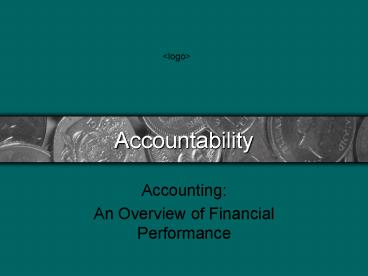Accountability - PowerPoint PPT Presentation
Title:
Accountability
Description:
Accountability Accounting: An Overview of Financial Performance Accounting Defined A Business Example: Highlights Income Revenue by Division Balance Sheet ... – PowerPoint PPT presentation
Number of Views:232
Avg rating:3.0/5.0
Title: Accountability
1
Accountability
ltlogogt
- Accounting
- An Overview of Financial Performance
2
Accounting Defined
- The American Institute of Certified Public
Accountants defines accounting as "the art of
recording, classifying, and summarizing in a
significant manner in terms of money,
transactions and events which are, in part at
least, of a financial character, and interpreting
the results thereof."
3
A Business Example
The Acme Corporation supplies products and
services to people world-wide. This presentation
provides an overview of our financial
performance. Unless marked as Company
Confidential, all information has been made
public.
- Highlights
- Income
- Revenue
- Balance Sheet
- Assets
- Stock Performance
4
Highlights
(in millions) 1999 2000
Net revenues x,xxx x,xxx
Net income xxx xxx
Earnings per share xxx xxx
Return on net revenues xx xx
Cash and s/t investments xxx xxx
Total Assets x,xxx x,xxx
Stockholders equity xxx xxx
5
Income
NetRevenues
NetIncome
Earnings / Share
6
Revenue by Division
7
Balance Sheet
1999 2000
Assets Cash and short-term investments Accounts receivable Inventories Other x,xxx xxx xxx xxx x,xxx xxx xxx xxx
Total Assets x,xxx x,xxx
Liabilities Accounts payable Accrued compensation Income taxes payable Other x,xxx xxx xxx xxx x,xxx xxx xxx xxx
Total Liabilities x,xxx x,xxx
Shareholders Equity x,xxx x,xxx
8
Assets
9
Stock Performance
Stock Performance to Date
10
How Accountants Think
- There is a direct correspondence between
reality and knowledge we have of it through
financial reports. - Objective is to give as accurate and true a
picture of what happened (transactions) and where
we stand (financial condition) as humanly
possible.
11
Accounting Records
- The Books
- Ledgers record changes in condition
- Journals record, classify and summarize specific
transactions. - Charts of accounts list classification scheme for
recording transactions - Income
- Expenditures
12
Basic Formula
- Financial condition at a given moment
- Changes over time
- All accounting systems use three fundamental
terms - Assets (What we own or hold)
- Liabilities (What we owe)
- Equity (Difference)
- A-L E
13
Two Other Basic Components
- Record changes
- Income (Inflows of Assets)
- Expenditures (Outflows of Assets)
14
Ledger Accounts
- Ledgers have five sets of accounts that all
together should be in balance - Assets, liabilities, equities, income and
expenditures. - All transactions are recorded twice (double-entry
bookkeeping) - Sum of all right hand columns should equal sum of
all left hand columns
15
Disaggregation
- Any ( usually all) of these five can be
sub-divided into many more possibilities. - Asset Cash inventory
- Liability Current long-term (e.g.mortgage)
- Equities Categories
- Income Revenue, Donations, Grants
- Expenditures Salaries, Fringes, Rent, etc.
- Sub-categories must always total to the whole.
16
Assets
- Debit (Left side) Additions to Assets
- What we own
- Cash on hand
- Inventory
- Receivables (What we are owed)
- Credit (Right side) Reductions of Assets
- What we have spent
- Major offsetting entries are Income, Expenditures
and Equity.
17
Liabilities
- Debit side Mostly adjustments and corrections
- Credit side What we owe (payables)
- In nonprofits, often a very limited category.
- Major offsetting entries are in Expenditures
(bought but not paid for) and Equity (reducing
capital)
18
Equity
- In nonprofits, has one of two names
- Fund accounting Fund balances
- Net income accounting Net income
- Left (debit) offsetting entries are Liability
credits (right). - Right (credit) offsetting entries are Asset
debits (left).
19
Inflows
- Left Mostly adjustments
- Right
- What we have received
- Revenue
- Support
- What we expect to receive
- Off-setting entries are in Assets
20
Expenditures
- Left (debits) reduce assets (paid) or increase
liabilities (payables). - Right (credits) are mostly corrections and
adjustments.
21
Quickbooks
- Small nonprofits (under 250,000) with limited
payroll and limited accruals can get good
service out of Quickbooks - URL http//www.quickbooks.com
- They have a 30-day trial period you can sign up
for.
22
GAAP Financial statements
- The purpose of keeping these records (the
books) is to produce accurate financial
statements. - Nonprofit financial statements
- Financial Position (Assets, Liabilities Equity)
- Statement of Activities (Changes in Net Assets)
- Cash Flows (Operations, Investments, Financing)
- Functional Expenditures































